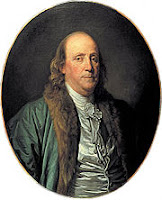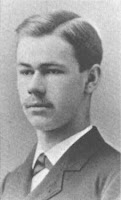Nor is it always in the most distinguished achievements that men's virtues or vices may be best discovered: but very often an action of small note, a short saying, or a jest, shall distinguish a person's real character more than the greatest sieges, or the most important battle.
Plutarch
Greek biographer & moralist (46 AD - 120 AD)

Seventy-six years ago this month, construction began on the
Golden Gate Bridge. Surprisingly, at least to me, the bridge was not an idea that was immediately embraced by everyone living in the San Francisco Bay area. Vested self-interest reared its head, as it almost always does, in the form of opposition and law suits from the ferry boat companies and even the labor unions (who worried that jobs might be given to non-union workers). Despite the delays in beginning of construction, the compelling need for a bridge finally prevailed and work began in January, 1932.
The bridge was a dream of many but it found its most outspoken champion in
Joesph B. Strauss. Strauss owned a bridge-building company that was well-known for building much smaller lift bridges, but he had never built anything of this scale before. Strauss was a dreamer, having studied poetry as well as engineering in college at the University of Cincinnati. His senior thesis was a proposed design for a railroad bridge connecting Alaska and Russia across the Bering Strait. But Strauss also suffered from an almost unquenchable need for personal recognition and glory, traits which would become apparent during the construction of the Golden Gate Bridge.
Strauss proposed an ugly cantilever-style bridge in his early designs for the Golden Gate project. The first design was a mass of steel girders that would also have cost far more than the city of San Francisco was prepared to spend. Strauss made the acquaintance of
Charles Alton Ellis who was a well-known structural engineer (despite the fact that he had no engineering degree, only a background in math and Greek). Ellis in turn collaborated with New York-based
Leon Moisseiff. The two proposed to Strauss that a suspension bridge could be built with far less material and hence lower cost. Not inconsequentially, the bridge design was also graceful. Strauss was a pragmatist and quickly got behind the design which was the basis for the bridge that we see today. Also leading the design team was a relatively unknown San Francisco architect named
Irving Morrow who provided many of the design details including the art deco designs of the towers, lights, hand rails and other details. He also proposed the characteristic red-orange color for the bridge that is so characteristic of the landmark. (The color was chosen both for its visibility in the fog as well as the aesthetics of fitting into the earthen landscape of the area.
Strauss made sure that he was the public face for the creation of the bridge. The recognition of his other chief collaborators was long downplayed and their major contributions have been recognized only in more recent years. Strauss in a fit of jealousy ordered Ellis to take a vacation shortly after construction got underway. While away, Strauss wrote to Ellis that he need not return as his employment was terminated. Ellis tried to find other work but this was the Depression and he could not find anything else. Ellis continued to work on his own time seventy-hour weeks for over six months to check the design calculations on the bridge that he loved so well.
Strauss made it to the dedication of the bridge in May, 1937. He even wrote a poem for the dedication and there is a statue of him at the south end of the span. But his moment in the limelight was to be short-lived. He died of a stroke the next year at the age of sixty-eight. While his realization of the dream of a bridge across the Golden Gate remains a testament to the best in the man, his exclusion of his key collaborators from the recognition they deserved tells us much more about his character. Strauss would have been far better to share the recognition to create the lasting legacy that he craved.









